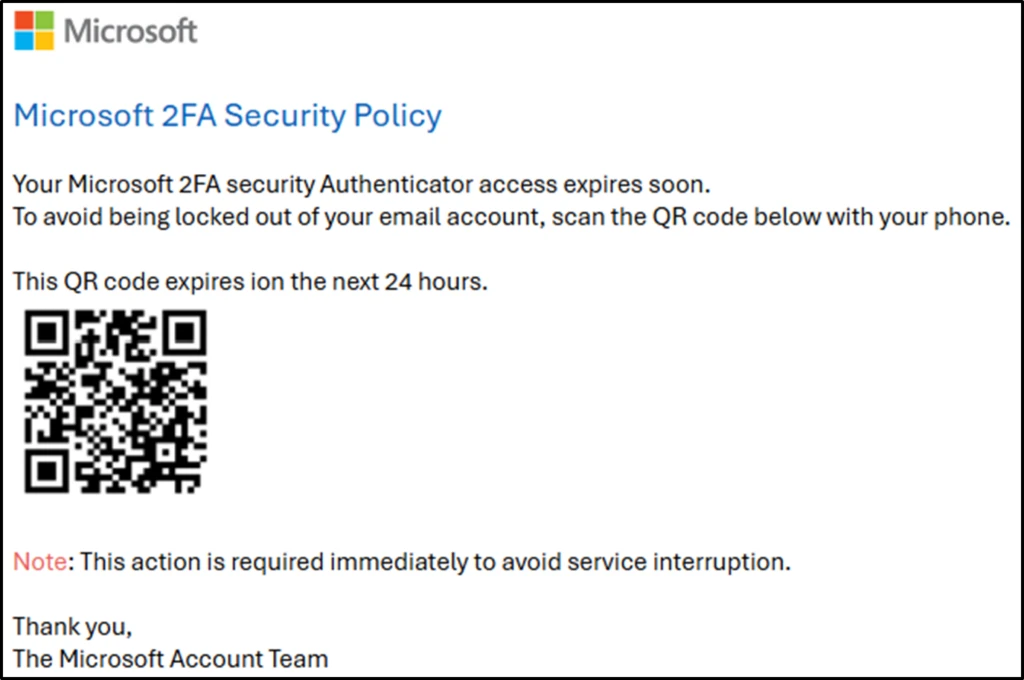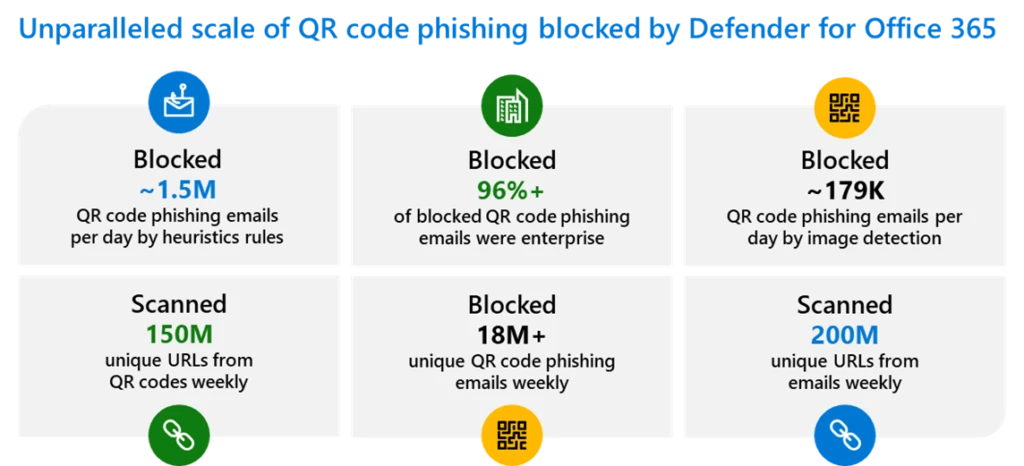
Over the last year, the cybersecurity industry faced a significant surge in QR code phishing campai 2024-11-5 01:0:0 Author: www.microsoft.com(查看原文) 阅读量:9 收藏
Over the last year, the cybersecurity industry faced a significant surge in QR code phishing campaigns, with some attacks increasing at a growth rate of 270% per month.1 A QR code (short for “Quick Response code”) is a two-dimensional barcode that can be scanned using a smartphone or other mobile device equipped with a camera. The codes can contain information like website URLs, contact information, product details, and more. They are most often used for taking users to websites, files, or applications. But when bad actors exploit them, they can be used to mislead users into unwittingly compromising their credentials and data.
Unique characteristics of QR code phishing campaigns
Like with other phishing techniques, the goal of QR code phishing attacks is to get the user to click on a malicious link that seems legitimate. They often use minimalistic emails to deliver malicious QR codes that prompt seemingly legitimate actions—like password resets or two-factor authentication verifications. A QR code can also be easily manipulated to redirect unsuspecting victims to malicious websites or to download malware in exactly the same way as URLs.

Figure 1. QR code as an image within email body redirecting to a malicious website.
The normal warning signs users might notice on larger screens can often go unnoticed on mobile devices. While the tactics, techniques, and procedures (TTPs) vary depending on which bad actor is at work, Microsoft Defender for Office 365 has detected a key set of patterns in QR code phishing attacks, including but not limited to:
- URL redirection, where a click or tap takes you not where you expected, but to a forwarded URL.
- Minimal to no text, which reduces the signals available for analysis and machine learning detection.
- Exploiting a known or trusted brand, using their familiarity and reputation to increase likelihood of interaction.
- Exploiting known email channels that trusted, legitimate senders use.
- A variety of social lures, including multifactor authentication, document signing, and more.
- Embedding QR codes in attachments.
The impact of QR code phishing campaigns on the broader email security industry
With the most common intent of QR code phishing being credential theft, malware distribution, or financial theft, QR code campaigns are often massive—exceeding 1,000 users and follow targeted information gathering reconnaissance by bad actors.2
Microsoft security researchers first started noticing an increase in QR-code based attacks in September 2023. We saw attackers quickly morphing their techniques in two keys ways: First by manipulating the way that the QR code rendered (such as different colors and tables), and second by manipulating the embedded URL to do redirection.
The dynamic nature of QR codes made it challenging for traditional email security mechanisms that were designed for link-based phishing techniques to effectively filter and protect against these types of cyberattacks. A key reason was the fact that extensive image content analysis was not commonly done for every image in every message, and did not represent a standard in the industry at the time of the surge.
As a result, for several months our customers saw an increase in bad email that contained malicious QR codes as we were adapting and evolving our technology to be effective against QR codes. This was a challenging time for our customers and those of other email security vendors. We added incremental resources and redirected all our engineering energy to address these issues, and along the way not only delivered new technological innovations but also modified our processes and modernized components of our pipeline to be more resilient in the future. Now these challenges have been addressed through a key set of innovations, and we want to share our learnings and technology advancements moving forward.
For bad actors, QR code phishing has become a lucrative business, and attackers are utilizing AI and large language models (LLMs) like ChatGPT to increase the speed and improve the believability of their attacks. Recent research by Insikt Group noted that bad actors can generate 1,000 phishing emails in under two hours for as little as $10.3 For the security industry, this necessitates a multifaceted response including improved employee training and a renewed commitment to innovation.
The necessity of innovation in QR code phishing defense
Innovation in the face of evolving QR code phishing risk is not just beneficial, it’s imperative. As cybercriminals continually refine their tactics to exploit new technologies, security solutions must evolve at a similar pace to remain effective. In response to the growing threat of QR code phishing, Microsoft Defender for Office 365 took decisive action to leverage advanced machine learning and AI—developing robust defenses capable of detecting and neutralizing QR code phishing attacks in real time. Our team meticulously analyzed these cyberthreats across trillions of signals, gaining valuable insights into their mechanisms and evolving patterns. This knowledge helped us refine our security protocols and enhance our platform’s resilience with several strategic updates. As the largest email security provider, we have seen a significant decline in QR code phishing attempts. At the height, Defender for Office 365 was blocking 3 million attempts daily, and with the delivery of innovative protection we have seen this number shrink to 200,000 QR code phishing attempts every day. This is testament that our innovation is having the desired effect: reducing the effectiveness of QR code-based attacks and forcing attackers to shift their tactics.

Figure 2. QR code phishing blocked by Microsoft Defender for Office 365.
Recent innovations and protections we’ve implemented and improved within Microsoft Defender for Office 365 to help combat QR code phishing include:
- URL extraction enhancements: Microsoft Defender for Office 365 has improved its capabilities to extract URLs from QR codes, substantially boosting the system’s ability to detect and counteract phishing links hidden within QR images. This enhancement enables a more thorough analysis of potential cyberthreats embedded in QR codes. In addition, we now extract metadata from QR codes, which enriches the contextual data available during threat assessments, enhancing our ability to detect suspicious activities early in the attack chain.
- Advanced image processing: Advanced image processing techniques at the initial stage of the mail flow process allow us to extract and log URLs hidden within QR codes. This proactive measure disrupts attacks before they have a chance to compromise end user inboxes, addressing cyberthreats at the earliest possible point.
- Advanced hunting and remediation: To offer a comprehensive response to QR code threats across email, endpoint, and identities with our advanced hunting capabilities, security teams across organizations are well equipped to specifically identify and filter out malicious activities linked to these codes.
- User resilience against QR code phishing: To further equip our organization against these emerging threats, Microsoft Defender for Office 365 has expanded its advanced capabilities to include QR code threats, maintaining alignment with email platforms and specific cyberattack techniques. Our attack simulation training systems along with standard setup of user selection, payload configuration, and scheduling, now have specialized payloads for QR code phishing to simulate authentic attack scenarios.
Read more technical details on how to hunt and respond to QR code-based attacks. By integrating all these capabilities across the Microsoft Defender XDR platform, we can help ensure any QR code-related threats identified in emails are thoroughly analyzed in conjunction with endpoint and identity data, creating a robust security posture that addresses threats on multiple fronts.
Staying ahead of the evolving threat landscape
The enhancements of Microsoft Defender for Office 365 to defend against QR code-based phishing attacks showcased our need to advance Microsoft’s email and collaboration security faster. The rollout of the above has closed this gap and made Defender for Office 365 effective against these attacks, and as the use of QR codes expands, our defensive tactics will now equally advanced to combat them.
Our continuous investment in analyzing the cyberthreat landscape, learning from past gaps, and our updated infrastructure will enable us to effectively handle present issues and proactively address future risks faster as threats emerge across email and collaboration tools. We will soon be sharing more exciting innovation that will showcase our commitment to delivering the best email and collaboration security solution to customers.
For more information, view the data sheet on protecting against QR code phishing or visit the website to learn more about Microsoft Defender for Office 365.
Learn more
To learn more about Microsoft Security solutions, visit our website. Bookmark the Security blog to keep up with our expert coverage on security matters. Also, follow us on LinkedIn (Microsoft Security) and X (@MSFTSecurity) for the latest news and updates on cybersecurity.
1Attackers Weaponizing QR Codes to Steal Employees Microsoft Credentials, Cybersecurity News. August 22, 2023.
2Hunting for QR Code AiTM Phishing and User Compromise, Microsoft Tech Community. February 12, 2024.
3Security Challenges Rise as QR Code and AI-Generated Phishing Proliferate, Recorded Future. July 18, 2024.
如有侵权请联系:admin#unsafe.sh